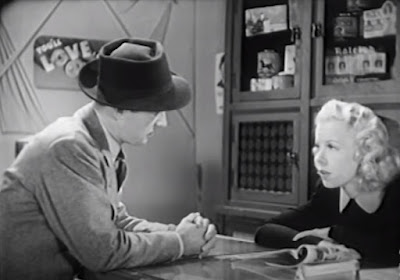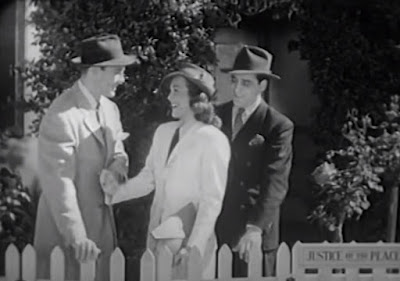This movie is a mess.
It's like they took all the things that would connect up the different parts of the story and chopped them out, assuming the audience would just jump merrily from conclusion to conclusion. Or something.
The message of the movie is clear: don't shun the children of criminals for what their parents did, or else they might become criminals themselves. And I can get behind that message. In fact, it's a good message, and deserves a coherent story to present it. Alas, that's exactly what it doesn't get in
Paper Bullets (1941), which is also known as
Gangs, Inc. because why not give it two titles? People are already confused. It's fine.
Also, I suspect that the title cards at the beginning got redone when it was shown on TV in the late 1940s, after Alan Ladd became a big star, because he really just has a small (yet pivotal!) part, but his name is listed at the top in big, bold letters. Maybe that's when it was retitled too? The poster to the left is completely and utterly misleading, by the way. Alan Ladd's character is not a hardened criminal who can kill you by glaring at you. Though I guess we do see a mugshot of him at one point -- actually, of one of his characters. He sort-of is playing two characters, though we really only ever see one of them.
Like I said, it's a mess. Let's dig in and get our hands dirty exploring it, shall we?
The whole thing opens when a little girl named Rita Adams is reunited with her dad, who just got out of prison. They get to live happily together again for two minutes and forty-two seconds, and then her dad is gunned down at her playground while shielding little Rita behind him.
Rita grows up in an orphanage, where she makes friends with Bob and Mickey. Bob is a smart guy and Mickey is a tough guy, and Rita is pals with both, though she likes Bob more. We get one whole scene in the orphanage, which is only there to introduce the guys and show us that Rita has a birthmark behind her left ear because that will be important for exactly two seconds when our story lurches into Rita's adult life -- we know the next person we see is Rita because of that birthmark.
Adult Rita (Joan Woodbury) shares an apartment with her sweet pal Donna (Linda Ware), works at a munitions plant or something, and is dating a rich drunk named Harold DeWitt (Phillip Trent). Her life is peachy keen for about four minutes, until she gets fired because her employers found out her dad spent time in prison. Donna says it's fine because the rent is paid, but Rita is NOT fine with this.
While out cruising around with Rita, her drunken boyfriend Harold kills someone in a hit-and-run accident. Harold's rich daddy's lawyer tells Harold to convince Rita to take the rap for him, even if it means promising to marry Rita. The lawyer tells Rita that she will get off lightly and not have to do prison time, but hahahaha, not true at all. She goes to prison.
When Rita gets out of prison twelve seconds after we saw her sentenced, her old friends Bob (John Archer) and Mickey (Jack LaRue) are waiting to pick her up, along with her bestie Donna. Good old Harold is nowhere to be seen.
Mickey has a bit of juicy news for Rita: Harold's dad, Clarence DeWitt (George Pembroke) paid the lawyer to make sure Rita went to jail so Harold wouldn't have to marry her. Naturally, this news prompts Rita to embark on a crime spree. Like every sensible girl who's discovered she was double-crossed by the man who said he'd marry her, she dons a blond wig and starts robbing rich guys, poker games, nightclubs, and brokerage firms. What else would she do with her time?
Donna never seems to glom onto the fact that Rita is a one-woman crime wave. The blond bandit in the papers can't be Rita because Rita has dark hair, obviously. Meanwhile, Rita's orphanage pal Mickey has become kind of a big deal with the New York mob, and he invites Rita and Donna to move to New York. Donna is a singer, and he promises to find her a place singing in a nightclub.
Everything goes super well in New York. We're only twenty-six minutes into the film, and Donna is a singing sensation! Rita has plans to keep busy in the big city too, of course. Heh heh heh.
Meanwhile, good old Harold's dad, Clarence DeWitt, has started stirring pots and claiming that the New York police are in league with the mob. The police chief cooks up a great plan to prove this is not true and that it's DeWitt who is in with the mob. His plan? Have a sweet policeman wannabe named Jimmy Kelly (Alan Ladd) pretend to be mobster Bill Dugan (also Alan Ladd, but with messy hair) and infiltrate the mob to gather evidence.
This is a fool-proof plan. Jimmy Kelly has never been trained in how to be a policeman, much less how to pass himself off as a mobster, but since he's identical to Bill Dugan, it'll be fine. Never mind that Dugan isn't even in prison or some other city -- he's here in New York too, but obviously that won't complicate anything.
(I was really hoping for some split-screen action where Alan Ladd confronts Alan Ladd for impersonating himself, but that clearly was too fancy for this B picture, so all we get is two photographs to compare. Sigh.)
Because there are only four or five mobsters in all of NYC, Bill/Jimmy works with Mickey to collect bribes. This gives Alan Ladd some chances to work on his Tough Guy act, as well as practice delivering barbed banter, which is the most fun this movie provides. I never said the movie had nothing going for it.
We get treated to Leaning Alan Ladd...
...Hat-Tipping Alan Ladd...
...Smiling Alan Ladd...
...and Desk-Perching Alan Ladd! You can collect them all!
Anyway, old man DeWitt gets a grand jury rolling to investigate a bunch of mobsters. Rita decides this is her chance to get back at him for sending her to prison. She takes to the radio, spouting allegations about DeWitt being in league with the mobsters himself. Then she meets up with the mob bosses and says she can help them take DeWitt down or something, if only they'll let her be a mob boss too.
What mob boss in his right mind is going to turn down an offer like that? Clearly, this chick is capable of running a big crime organization. She knows how to talk on the radio, after all. And she has a Plan for a way to blackmail DeWitt into doing what she wants, which involves some incriminating letters that Mickey stole fifteen minutes earlier in the film.
Rita wants to become a mob boss so she can make lots of money and build a nice playground for underprivileged kids. I am not even joking.
Meanwhile, Bill/Jimmy and Donna have met up and gotten friendly. They engage in some cute flirtation in Donna's dressing room, where Donna begs Bill/Jimmy to give up racketeering and get an honest job.
Bill/Jimmy alllllmost tells Donna he's actually a good guy.
But he doesn't. Which is probably wise.
This is the best scene of the whole movie, so pardon me if we lingered there a bit.
Bill/Jimmy gets to give the movie its original title: "Paper bullets" are votes. Now you know.
Some plot happens. The bad guys discover, accidentally, that Bill/Jimmy is really Jimmy, not Bill at all, through no fault of his own. Three bad guys take Jimmy on a little ride, resulting in the absolute worst car chase scene in the history of cinema.
The police chief and a pal chase that car around, trying to rescue Bill/Jimmy. The entire chase scene consists of shots of bored people inside the cars alternated with shots of black cars zooming around at night.

You can't tell which car is which or what is going on. At all. And this goes on for a little over two minutes. Then, one car... goes over a cliff or something? The only way we know it was the mobster car is that the police chief and his friend jump out of their car and look over the edge.
Since Bill/Jimmy was in that car, we can assume he has died. That's certainly what Rita and Donna assume.
We, the viewers, are left to assume exactly that for nearly nineteen whole seconds before the police chief reveals, with a chuckle, that it's not true at all, we're just faking Bill/Jimmy's death. Because of reasons.
Then Rita and Bob (remember Bob from the orphanage?) get married! Bob is an airplane designer or something? Totally decent guy. No idea that his new wife and her best friend Mickey are mobsters. That is, not until they've been married for a minute and a half, when a guy shows up with an arrest warrant and subpoena for Rita as they leave the Justice of the Peace's office.
There go her plans to build a big playground for underprivileged kids!
Mickey kills somebody for something, we have a bunch of courtroom stuff that drags on for at least three minutes, and then the police spring a surprise witness: Bill/Jimmy! He's alive!
Donna is super happy to see him! Mickey is not, and tries to shoot him (because he totally just waltzed into the courtroom packing a gun in a shoulder holster and nobody cared). But that was just the evidence the police wanted to arrest Mickey too. The mob bosses, including Rita, are all found guilty and sentenced to prison. Poor Bob vows he'll wait for her and be faithful to her for as long as it takes for her to get released. (At the clip this movie travels, that should take about forty seconds, but who's counting?)
I guess Donna got her playground built after all, even though she went to prison, because this is the movie's final shot. I would totally play in a playground with a creepy sign like this on its gate, wouldn't you?
I spent way too much time taking screencaps of this mess. I hope you enjoyed them. At least Alan Ladd is super cute in it, and he gets a fair bit to do, too!
Either this movie is in the public domain, or it's so nonsensical that no one cares to protect it, because you can
watch it on YouTube with no problem. Just in case you like movies that make no sense! Or you want to see a prototype of Alan Ladd's tough-but-actually-nice-inside characters.

This has been my contribution to the
Second Annual Favorite Stars in B Movies Blogathon hosted by
Films from Beyond the Time Barrier.

































